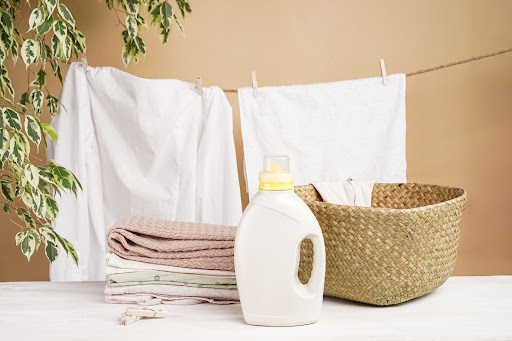Fabric softeners and conditioners make your clothes feel soft, smell great, and stay wrinkle-free. Depending on what your needs and preferences are, there are many different types of fabric softeners available. Whether you’re interested in learning about liquid fabric softeners, dryer sheets, or natural fabric softener solutions, we’ve got you covered.
In this guide, we will explore all the various types of fabric softeners and provide helpful tips on how to use them effectively. So, whether you’re a laundry novice or a seasoned pro, join us as we dive into all the do’s and don’ts of using fabric softeners.
What Is Fabric Softener?
Fabric softener is a type of conditioner specially formulated for clothing. These products are typically dispensed during the rinse cycle. One of the primary benefits of fabric softener is its ability to soften clothing and reduce wrinkling, which can minimize the need for ironing.
Fabric softeners also help prevent static cling among fibers, helping your clothes last longer. They reduce wear and tear on your clothing by reducing friction during the wash cycle. While fabric softener have many functional benefits, many of them are scented, leaving your clothes with a fresh and clean aroma.
When Should You Use Fabric Softener?

When in doubt about when you should use your favorite fabric softener, you should always defer to the directions on the bottle. Most fabrics can handle fabric softeners and conditioners; however, athleticwear and waterproof garments may not be compatible.
In clothes and garments that absorb moisture, fabric softeners may clog the spaces between the fibers and make them less effective over time. Additionally, you should never use fabric softeners on towels, as they could become less absorbent with repeated washes.
How to Use Liquid Fabric Softener
Fabric softener is a laundry essential that softens clothes and eliminates static cling to make ironing easier; follow this step-by-step guide to learn how to use fabric softeners like a pro for the best results.
Front and Top-Loading Washing Machines
Most front-loading and top-loading washing machines have similar steps. It’s important to check the instructions specific to your machine, but if those aren’t available, these general steps should work for many washers:
Measure: Use the cap provided with the fabric softener to measure the recommended amount according to the packaging.
Add: Pour the pre-measured fabric softener into the automatic dispenser tray. In top-loading washing machines, the dispenser is usually located in the central column.
Wash!
Automatic Dispensers
In machines with automatic dispensers, the dispenser is typically found in the central column. To use an automatic dispenser, measure the correct amount of fabric softener or conditioner using the fill lines in the cap. Next, pour it into the dispenser at the same time you add your detergent.
During the spin cycle, the water level will rise and evenly distribute the fabric softener throughout the water to soften and protect your clothing from fading and stretching.
No Dispenser
Let’s say you just finished shopping for fabric softeners and found one with the perfect scent to use on your clothing, only to get home and find that your washing machine doesn’t have a dispenser for fabric softener! No need to worry; even if your washer doesn’t have a dispenser for fabric softener, it’s still possible to make sure your clothes smell great and remain wrinkle-free.
If your washing machine does not have a dispenser, add the fabric softener during the rinse cycle, as the wash cycle may wash it off of your clothes. During the rinse cycle, pour the recommended amount of fabric softener into the washing machine. When adding the fabric softener into the machine, be careful to pour it into water pockets throughout the load and not directly onto the clothing, as it may stain your favorite garments.
Other Types of Fabric Softeners
Dryer Balls
Wool dryer balls are an environmentally friendly alternative to single-use dryer sheets and liquid fabric softeners. While dryer balls are typically made out of tightly wound wool, they are also available in other materials such as rubber and plastic.
Like any other fabric softener, they prevent your laundry from sticking together in the dryer and eliminate wrinkles and static. As the dryer balls tumble between layers of clothing in the dryer, warm air can travel throughout the fabric and dry individual articles of clothing faster.
Dryer Sheets
Dryer sheets are small thin sheets that go into the dryer with your wet clothing. They are coated with stearic acid, fragrances, and other chemicals to remove wrinkles and static from all types of fabrics.
As the stearic acid on the dryer sheets melts, it makes its way onto your clothes and reduces static while softening them up during the drying process. Compared to liquid fabric softeners, dryer sheets are inexpensive and easy to use– all you have to do is pop them into the dryer with your clothing and start the dryer!
Many dryer sheets will instruct you to use one or two in the dryer before you start the cycle. Using too many dryer sheets can cause items like towels to lose absorbency, so be sure to follow the instructions on the packaging to be safe.
Let the Professionals Take Care of It

Using fabric softener is an easy and effective way to keep your clothes feeling soft and fresh, reduce static cling, and make ironing easier. By following the step-by-step guide outlined above, you can ensure that you’re using fabric softener the right way and getting the most out of this laundry essential. So go ahead and grab a bottle of your favorite fabric softener or box of dryer sheets and enjoy the soft and cozy benefits!
If you are short on time and need your clothing cleaned and handled professionally, try using a cleaning service like ZIPS. At ZIPS, we treat your garments with the utmost care to maximize their longevity and keep you looking your best every day of the week. Find a location near you, and let us take care of it today!

